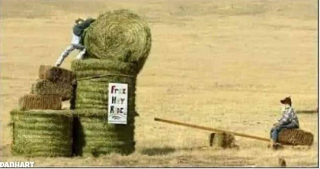Fun with Basic Physics

The first thing to do is estimate the mass of the cylindrical bale, which, per this article, isn’t an exact science. Let’s guess it’s 400 kg, and that it will be falling 2 meters. Suppose the kid weighs 50 kg and the smaller bale weighs another 50 kg, for a total of 100 kg.
Let’s use the theory of the conservation of momentum. The mass times the velocity of the falling bale at left will equal the mass times the velocity of the kid at right. m1v1 = m2v2.
Let’s first find out how long it takes the big bale to hit the lever, using x = ½ at2, where x is the distance traveled (2m), a is the gravitational acceleration (9.8 m/s2), and t is the time in seconds. Solving for t, we get 0.7 seconds. Since velocity (v) = acceleration (a) * time (t), we get v = ~7 m/s.
m1v1 = m2v2, we get (400)(7) = (100)(vkid), so (vkid) = 28 m/s.
Now, let’s see what happens. Using v = at again, we have 28 m/s = 9.8 m/s2 * t, so it takes the kid 3 seconds to reach his zenith. Again using x = ½ at2, we get x = ½*9.8* 3, or about 15 meters (49 feet), from which he’ll now fall, doing a brisk 28 m/s (62.6 mph) when he hits the ground. That’s going to hurt, assuming that the incredible acceleration he experiences doesn’t break his neck and kill him instantly. I hope this is an artist’s rendering.
Btw, the physics here is the reason that sane people don’t fire guns into the air to celebrate New Years. Neglecting air resistance, the bullet hits the ground with the same velocity it had when it left the muzzle.
